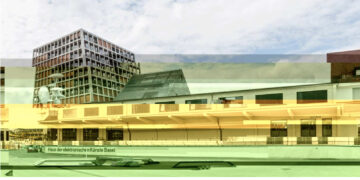Ted Davis
GLITCH.ext, 09.03.2021

Ted Davis' GLITCH.ext enables visitors to glitch HEK's virtual façade and the website hek.ch. Images, texts, and every HTML element forming the website's structure could be glitched by the visitor with the click of a mouse. If one continued to move the mouse over the chosen element, it is possible to influence the outcome of the glitch. Building on the artist's recent p5.glitch (2020) – a byte-level glitching library within p5.js – a companion browser extension for Chrome also allows users to keep glitching the rest of the web. GLITCH.ext was visible from 09.03.2021 to 13.04.2021 on thewebsite hek.ch.
The Chrome extension GLITCH.ext can be installed from the Web Store or manually from GitHub.
Statement by the artist:
"As culture transitioned from physical to virtual during the past Covid-19 year, GLITCH.ext pays homage to glitch in both the analogue and digital domain: Firstly, to HEK's own glitch façade, H3333333K (2015) by !Mediengruppe Bitnik, an architecturally implemented JPEG-glitch. Secondly, glitching websites incites Glitch Browser
(2005) by Dimitre Lima (DMTR), Ant Scott (BEFLIX) and Iman Moradi,
which JPEG-glitched all images of a given website via proxy server.
During my master studies here in Basel (2007-2009), resulting in a
thesis focused on glitching the JPEG file format, Precise Mishandling of
the Digital Image Structure, virtual exchange with the artists behind
Glitch Browser and local video-sniffing workshops by !Mediengruppe
Bitnik helped shape my developing practice. They joined a growing
exposure to notions of revealing the invisible, exploiting digital media
below the surface, and networked art. Starting with TEXT2IMAGE and HEADer_REMIX (2009),
throughout the past 10+ years, glitch continues to find its way into my
work, with its endless stream of surprising images and unique artefacts
to discover."
Ted Davis is a media artist, designer and educator originally from the United States and based in Basel, Switzerland. Since 2010 he teaches interaction design within the Visual Communication Institute at the Basel School of Design HGK FHNW. His work and teachings explore the volatility of digital media through glitch and reactivating older ‘new media’ through newer programming means. His open-source projects (basil.js, XYscope, P5LIVE) enable designers to program within Adobe InDesign, render vector graphics on vector displays, and collaboratively create live coded visuals.